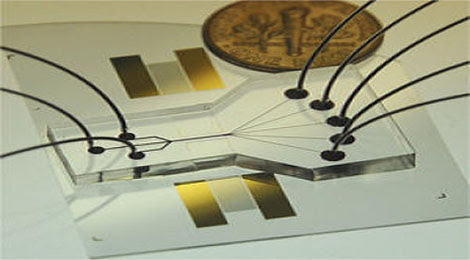The line between "interesting" and practical in advanced electronics
and optics often comes down to making the new device compatible with
existing technology. According to NIST scientist Kartik Srinivasan, the
new 0.5 mm x 0.05 mm-sized heralded photon generator meshes with
existing technology in three important ways: it operates at room
temperature; it produces photons compatible with existing
telecommunications systems (wavelengths of about 1550 nanometers); and
it's in silicon, and so can be built using standard, scalable
fabrication techniques.
This is an illustration of the process of photon pair generation, in
which input pump photons spontaneously generate special pairs of new
photons that emerge at precisely the same time, with one at a slightly
lower frequency and the other a slightly higher frequency, after which
heralding occurs.
A "heralded" photon is one of a pair whose existence is announced by
the detection of its partner -- the "herald" photon. To get heralded
single photons, the group built upon a technique previously demonstrated
in silicon called photon pair generation.
In photon pair generation, a laser pumps photons into a material
whose properties cause two incoming pump photons to spontaneously
generate a new pair of frequency-shifted photons. However, while these
new photons emerge at precisely the same time, it is impossible to know
when that will occur.
"Detecting one of these photons, therefore, lets us know to look for
its partner," says Srinivasan. "While there are a number of applications
for photon pairs, heralded pairs will sometimes be needed, for example,
to trigger the storage of information in future quantum-based computer
memories."
According to Srinivasan, the group's silicon-based device efficiently
produced pairs of single photons, and their experiment clearly
demonstrated they could herald the presence of one photon by the
detection of the other.
While the new device is a step forward, it is not yet practical,
according to co-author Professor Shayan Mookherjea at UC San Diego,
because a single source is not bright enough and a number of other
required functions need to be integrated onto the chip. However, putting
multiple sources along with their complementary components onto a
single chip -- something made possible by using silicon-based technology
-- could supply the performance needed for practical applications.
The work was among the three finalists and received an honorable mention in the Maiman Student Paper Competition.
From sciencedaily
















